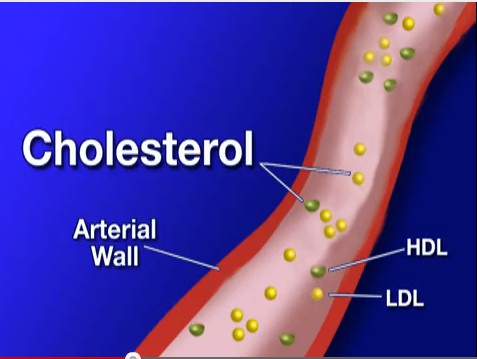High LDL cholesterol levels are responsible for the constriction of the arteries which puts one in increased risk of developing cardiovascular diseases. A person with high levels of LDL cholesterol may not show any symptoms until the disease has already become a life-threatening condition. Checking LDL cholesterol levels regularly is extremely important to determine the risk associated with high LDL cholesterol.
Although elevated LDL cholesterol is one of the risk factors of developing heart diseases, several things can be done to lower or prevent it from rising any further. This mainly involves making drastic dietary and lifestyle changes in order to prevent high LDL cholesterol levels from becoming a life-threatening medical condition.

What is LDL cholesterol?
LDL stands for low density lipoprotein as LDL particles are less dense compared to other types of cholesterol particles. Because cholesterol is not dissolved in the blood, it needs to combine with lipoproteins to it to its designated location. However, the chemical structure of the LDL cholesterol is not intended for this function and it simply drops the cholesterol along the way. As cholesterol oxidizes in the arteries, it forms into a plaque characterized by a lump in the arterial wall which hinders blood flow. When this bump ruptures, blood will clot on the area resulting to heart attack.
How much should LDL cholesterol levels be?
An optimal level of LDL cholesterol should be anywhere between 100 mg/dL to 129 mg/dL. For people with other risk factors of developing cardiovascular diseases, they should aim for LDL cholesterol levels less than 100 mg/dL, while those that are at high risk should target below 70 mg/dL LDL cholesterol level.
What does elevated LDL cholesterol mean?
Heart attacks will most likely happen to people with increased LDL cholesterol levels. The greater the LDL value, the higher the chances of developing a cardiovascular disease. People with increased LDL cholesterol may not know their condition until the heart disease is already in its advanced stages. This is because an increased LDL cholesterol level poses no sign or indicator that will have you worried. But when the increased LDL cholesterol comes with other risk factors, signs and symptoms may come in the form of:
- Atherosclerosis
This condition is characterized by the narrowing and hardening of arteries, wherein the patient will feel pain on his or her extremities, like on the feet and legs.
- Xanthomas
This skin condition is typified by the build-up of fats underneath the skin surface, which resembles a bump or sore that feels soft and yellow in color. Xanthomas are usually flat with pointed distinct edges and often found on the knees, buttocks, elbows, hands and feet.
- Cardiovascular diseases
There are a number of cardiovascular diseases with differing signs and symptoms. But the common symptoms include breathing difficulty, dizziness, chest pain or angina, faster and abnormal heartbeats, listlessness, nausea and pain either in one or both shoulder and arms as well as neck, back and jaw.
Why do the LDL cholesterol levels elevate?
There are several reasons why LDL cholesterol levels increase, and these may differ from person to person. LDL cholesterol level may elevate due to:
- Unhealthy lifestyle
Unhealthy lifestyle and bad dietary choices contribute to increased LDL cholesterol levels. This could be due to high intake of trans fats and saturated fats as well as cholesterol-rich animal products; a sedentary lifestyle, obesity, cigarette smoking, alcohol consumption and diabetes mellitus.
- Age and gender
The body’s ability to maintain normal levels of cholesterol reduces from 45 years of age and onwards for men, or 55 years old and onwards for women. On the other hand, men are more likely to develop increased LDL cholesterol level than women as the female hormones boost the level of HDL cholesterol while lowering LDL cholesterol in the bloodstream.
- Genetic predisposition
Sometimes, increased LDL cholesterol levels run in the family through an active cholesterol-producing gene. People whose relatives or family members are suffering from diabetes will more likely have an increased level of triglycerides and LDL cholesterol.
- Impaired cholesterol sweeper
The liver not only produces cholesterol but also works in removing bad LDL cholesterol from the blood through its LDL receptors. Impaired LDL receptors can lead to elevated LDL cholesterol level.
How to lower LDL cholesterol naturally
An increased LDL cholesterol level can be lowered naturally through cholesterol lowering foods, and these are:
- Fiber-rich foods like oatmeal, prunes, barley, pears, apples and kidney beans
- Polyunsaturated fatty acids like peanuts, walnuts, almonds and hazel nuts
- Antioxidants like olive oil
- Omega-3 fatty acids found in tuna, mackerel, herring and salmon, including canola oil and flaxseed
Aside from eating cholesterol lowering foods, high-cholesterol foods must be minimized or totally avoided, and coupled with regular exercise for optimum result.
LDL cholesterol levels are important indicators of a healthy heart. An increase in the level of LDL cholesterol requires prompt action so as to avoid complications and life-threatening conditions that may result due to elevated LDL cholesterol level.